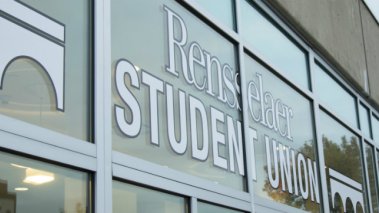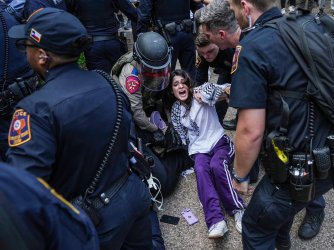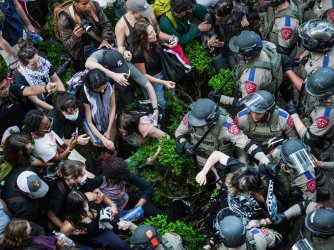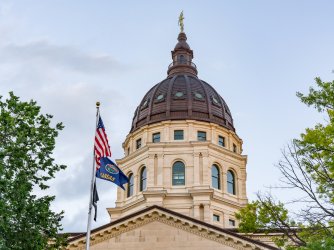Table of Contents
As Rensselaer Polytechnic Institute threatens more students with punishment, student body president highlights RPI’s missed opportunity

On Monday, we shared a letter we sent to Rensselaer Polytechnic Institute, a private institution in Troy, New York, where students are engaged in a long-running dispute with administrators about control of the Rensselaer Union. That quarrel has already seen RPI’s administration tearing down posters (on video), denying students’ requests for permission to demonstrate, and building a fence to keep student demonstrators far out of the earshot of donors at a black-tie fundraiser.
Now, RPI is suggesting it may seek to punish more students, again defying its express commitment to students’ freedom of expression.
In talking points prepared by RPI’s communications staff, and distributed to RPI board members, the school criticizes the “Save the Union” campaign’s anonymous leaders and intones that those who “have an ulterior motive have grossly twisted information to deliver a disinformation campaign.”
RPI’s talking points say that the nine other students who have been summoned to meetings are “not likely to reach the level of judicial” sanctions.
“Those leading the unapproved demonstration, or encouraging the crowd to cross the barrier and enter the event area will face appropriate judicial sanction,” it reads.
But that’s not what RPI told those students. Rather, they students were told: “Please know that you are not in any trouble, but it is important that we meet.”
Which is it? Not likely to, or aren’t?
RPI also faults “[t]hose who hide behind anonymity,” apparently because the “Save the Union” campaign has no formal, public leadership. But who could blame them for remaining anonymous? RPI has tried to use the mere act of speaking to the media as a basis to penalize students, and used police footage of demonstrators to identify students at a peaceful demonstration. That’s a pretty reasonable justification for students to want to remain anonymous.
As for RPI’s claim that a fireworks display necessitated fencing off a wide part of campus into a “no speech” zone? For one, RPI’s policies prohibit the institute from using “denial of access to facilities . . . as a means of censorship or suppression.” So when an RPI vice president linked the placement of the fence to the need to keep demonstrators away from “the event,” RPI was expressly denying access to facilities as a means to prevent student speech. Moreover, the demonstration occurred shortly after 5:00 p.m., but the fireworks were set to begin almost five hours later. So, RPI appears to have seized on the safety rationale as a pretext to create a no-speech zone.
Meanwhile, RPI Grand Marshal Justin Etzine — “Grand Marshal” is the title given to the student body president — has penned a thoughtful response. Etzine raises doubts about whether RPI had effectively communicated the need for an “event boundary,” adding that “‘leading’ the demonstration is neither commensurate with moving the barrier nor encouraging crossing of the barrier.” Etzine also counters Dean of Students Travis Apgar’s bemoaning over students’ anonymous speech, and rightly laments RPI’s missed opportunity to highlight its students’ engagement:
I believe the students coordinating the “Save the Union” efforts are hiding behind anonymity for legitimate reasons, first and foremost being a concern for their academic safety. The students who have been adjudicated as “leading” the October 13 protest have been hit with steep judicial charges in response to their participation. As a student leader who has personally experienced frightening ramifications as a result of merely representing my peers—which has included comments from administrators explicitly referencing expulsion—I understand all too well from where their concerns stem.
Much of this so-called “twisted information” is no fault of the students; rather, the information being disseminated by students is supported by references, research, facts, and eyewitness accounts. Given this hard work, I have to commend my fellow classmates for their research and their fact-based points. If the administration continues to point to misinformation as a major issue for discrediting students’ concerns and marginalizing students’ voices, then I ask: what misinformation is being spread? What ulterior motives could students possibly have? [. . .]
Our nation is clearly in a state of political contempt, and a number of universities and cities have sadly fallen victim to viciously dangerous and destructive protests. In sharp contrast, our students demonstrated poise, respect, calmness, and inclusivity in their October 13th demonstration. This could have served as a fantastic opportunity for positive attention for RPI, given how refreshingly passionate yet respectful our students are. Unfortunately, it has become apparent that free speech is not a right afforded to current RPI students, let alone one that is celebrated.
Etzine is right. RPI’s claims are more fuss than substance.
RPI could have highlighted its students’ commitment to the future of the Institute, even if there might be differences of opinion. Many collegiate institutions would be thrilled to have a student body that is so engaged in campus affairs, cares about the institution, and is ready to take the reins of leadership.
There’s still time for RPI to back down, but RPI administrators have shown no indication that they will discontinue their pursuit of sanctions. Instead of talking to their students, they’re drafting talking points.
Recent Articles
FIRE’s award-winning Newsdesk covers the free speech news you need to stay informed.

Texas tramples First Amendment rights with police crackdown of pro-Palestinian protests

Here’s what students need to know about protesting on campus right now

Kansas takes a stand for intellectual freedom
